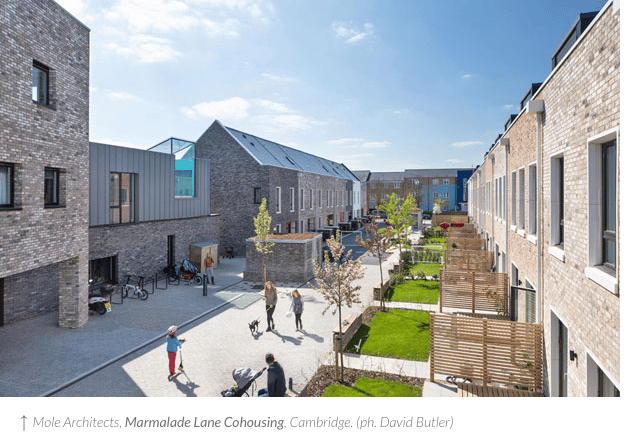Join our next In Person Info Session December 13 from 11am-1pm MST
Cohousing Around the World: A Global Perspective
This blog explores how cohousing communities differ around the world, focusing on cultural variations, challenges, and successes.
Gratitude Village
11/3/20244 min read


Cohousing Around the World: A Global Perspective
As people worldwide search for new ways to live that foster connection, sustainability, affordability and community, cohousing has emerged as an innovative solution. This alternative housing model, where residents intentionally come together to share resources, responsibilities, and social lives, is gaining traction across the globe. While the concept originated in Denmark in the 1960s and early 1970s, it has since spread to various cultures and contexts, each adapting the model to suit local needs and values. Exploring cohousing from a global perspective reveals the diverse ways in which communities are redefining what it means to live together.
The Birth of Cohousing in Denmark
Cohousing, or “bofællesskab” as it is known in Danish, began in Denmark in the 1960s. The idea was born out of a desire to create living environments that emphasized community, collaboration, and a balanced lifestyle. The first official cohousing community, Sættedammen, was established in 1972, setting the stage for what would become a movement toward intentional living.
In Denmark, cohousing is often characterized by shared common spaces, communal meals, and collective decision-making processes. Residents typically have private homes but come together for activities such as gardening, cooking, and social events. Danish cohousing communities prioritize sustainability, with many incorporating eco-friendly designs and practices. Today, cohousing remains a popular and respected housing option in Denmark with more than 700 communities and the movement influences other countries and serves as a model for communal living worldwide.
Cohousing in the United States
Cohousing made its way to the United States in the 1980s, largely inspired by the Danish model. The first American cohousing community, Muir Commons, was established in Davis, California, in 1991. Since then, the concept has grown steadily, with over 300 cohousing communities now in existence or being built across the country.
In the U.S., cohousing is often seen as a solution to the challenges of modern urban life, such as isolation, environmental degradation, and the high cost of living. American cohousing communities vary widely in size, design, and philosophy, but they all share a commitment to creating supportive, interconnected environments. Many U.S. communities emphasize sustainability, with features like energy-efficient buildings, shared gardens, and car-free zones. Additionally, cohousing in the U.S. often attracts a diverse group of residents, including families, retirees, and young professionals, all seeking a more intentional way of living.
Cohousing in Europe
Beyond Denmark, cohousing has taken root in many European countries, each adapting the model to its own cultural context. In the Netherlands, for example, cohousing is closely linked to the tradition of “woongroepen” (living groups), where residents share both living spaces and responsibilities. Dutch cohousing communities often focus on social integration, providing affordable housing options and fostering relationships between people of different backgrounds, ages, and abilities.
In Germany, cohousing is known as “gemeinschaftliches Wohnen” or “Baugruppen” (building groups). German cohousing communities often emphasize sustainability, with many adopting innovative ecological designs, such as passive houses and renewable energy systems. These communities are typically resident-led, with members actively involved in the planning and construction of their homes. The German government also supports cohousing through various initiatives, recognizing its potential to address housing shortages and promote social cohesion.
In the United Kingdom, cohousing is gaining popularity as a response to the growing sense of disconnection in modern society. British cohousing communities are often centered around shared values, such as environmental sustainability, social justice, or aging in place. The UK Cohousing Network has been instrumental in promoting the concept, providing resources and support for those interested in starting or joining a community.
Cohousing in Asia
While cohousing is less prevalent in Asia than in Europe or North America, it is beginning to gain traction in several countries. In Japan, for instance, cohousing is seen as a way to address the challenges of an aging population and the decline of traditional family structures. Japanese cohousing communities often emphasize intergenerational living, with older residents sharing their knowledge and experience with younger members, while also receiving support and companionship in return.
In China, the concept of cohousing is being explored as a solution to the rapid urbanization and housing shortages faced by many cities. Chinese cohousing projects often focus on sustainability, with designs that incorporate green spaces, energy-efficient buildings, and communal facilities. While the idea is still relatively new in China, there is growing interest in alternative housing models that can provide a sense of community and connection in the midst of rapid social change.
Cohousing in Australia and New Zealand
Cohousing has also found a home in Australia and New Zealand, where it is seen as a way to build more sustainable and socially connected communities. In Australia, cohousing is often linked to the “eco-village” movement, with communities focusing on environmental stewardship, social responsibility, and community-building. Australian cohousing communities vary in size and structure, from small urban developments to larger rural eco-villages.
In New Zealand, cohousing is emerging as a response to the challenges of housing affordability and social isolation. New Zealanders are increasingly interested in living arrangements that provide a sense of community and shared purpose. Cohousing communities in New Zealand often emphasize collaboration, with residents working together to design, build, and manage their shared spaces.
The Global Appeal of Cohousing
What makes cohousing so appealing across different cultures and contexts? At its core, cohousing addresses a fundamental human need: the desire for connection and community. In a world where traditional social structures are changing, and many people feel increasingly isolated, cohousing offers a way to rebuild social bonds and create supportive environments.
Cohousing also appeals to those who are passionate about sustainability and want to live in a way that is more in harmony with the environment. By sharing resources, reducing waste, and living more efficiently, cohousing communities can significantly reduce their ecological footprint.
Moreover, cohousing provides a sense of security and support that is often lacking in modern urban life. Knowing that you are part of a community where people look out for one another can alleviate many of the stresses and anxieties of daily life.
Conclusion
Cohousing is more than just a housing model; it is a global movement that reflects a growing desire for community, sustainability, and connection. From its origins in Denmark to its diverse manifestations around the world, cohousing offers a vision of a more connected and sustainable future. Whether in Europe, North America, Asia, or beyond, cohousing communities are proving that it is possible to live in a way that meets both our social and environmental needs. As more people around the world seek alternatives to traditional housing, cohousing will likely continue to grow, offering a compelling answer to the challenges of modern life.
COMMUNITY
Join us in embracing nature, diversity and connection.
Sustainability
DIVERSITY
info@gratitudevillageco.com
720-689-4821
© 2025. All rights reserved.
AFFORDABILITY
Gratitude Village Inc. is a 501(c)3 charitable corporation that values diversity, equity, and inclusion as essential to our mission
Subscribe to our Substack
Refund Policy




Gratitude Village is a Proud Member of these organizations
